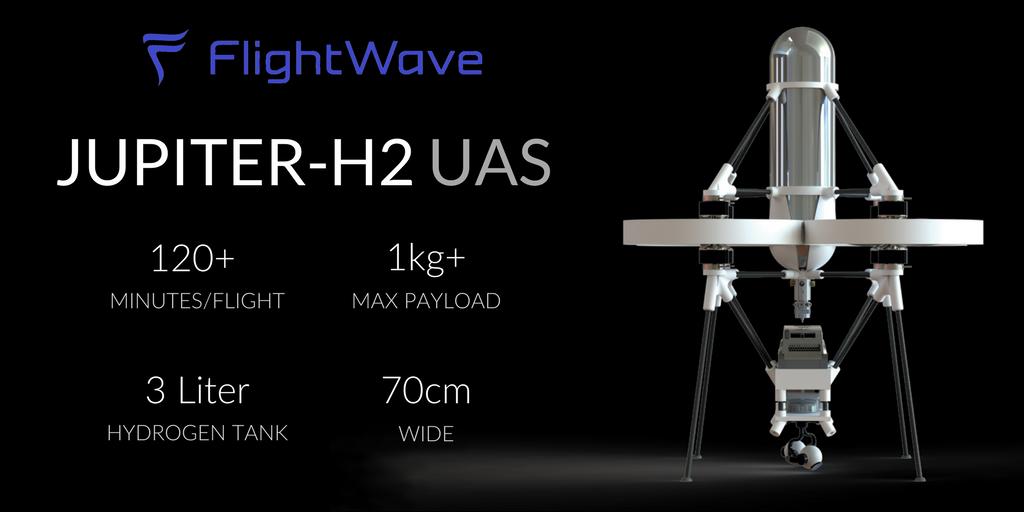Industry leading fuel cell technology from Intelligent Energy enables new UAS to fly farther, longer, and carry heavier payloads
Santa Monica, California (September 6, 2017)
FlightWave Aerospace Systems, Inc. announces its second offering to the UAS community: the hydrogen-powered Jupiter-H2. The hydrogen fuel cell technology powering the aircraft, which comes through a partnership with UK-based Intelligent Energy, gives the Jupiter-H2 heavy-lifting capability plus greater endurance.
The Jupiter-H2 uses a narrow-profile 70 cm airframe, with a high-thrust power plant consisting of eight motors driving cross-flowing fan blades. The three-liter hydrogen tank fuels nearly two hours of continuous flight, lifting up to almost three pounds of payload.
“We view the Jupiter-H2 as a game-changing vehicle,” said FlightWave CMO Edmund Cronin. “It’s particularly well suited to use cases requiring both long flight time and stable maneuverability in narrow indoor or outdoor spaces — for example, in a very large but cramped warehouse.”
Intelligent Energy’s hydrogen fuel cell technology makes the Jupiter-H2 far more capable than battery-powered UASs:
● High-endurance: Most quadcopters have limited flight times of about half an hour. The Jupiter-H2 nearly quadruples the flight endurance of those typical aircraft, thanks to hydrogen’s high energy-to-weight ratio — packing a lot more energy into each flight.
● Heavy Lift: Extra energy and lighter energy means more power to lift & carry your sensors.
● Clean, Quiet, and Emission Free: Fuel cells have no moving parts, they are virtually silent and pollution-free, emitting only a tiny amount of water vapor.
“Our partnership with Intelligent Energy has been a key element of the Jupiter-H2’s development,” added Cronin. “They are pushing the limits of hydrogen fuel cell technology, making the fuel cell lighter yet more powerful.”
The two hours of flight time is approximate and varies with the payload, which can be a maximum of 1,250 g (2.75 lbs), enabling simultaneous use of multiple sensors and cameras. Subsystems can draw power directly from the fuel cell, thus avoiding the need for those systems to carry their own batteries, which reduces overall weight.
The Jupiter-H2’s composite airframe maximizes strength, minimizing structural weight. Refueling takes minutes, instead of the hours of charge time a battery would require. Plus, it’s universal mount system accommodates almost any sensor or camera.
Julian Hughes, Senior VP of IE US Inc, said: “It’s great to be back at InterDrone launching this game changing product, just 12 months on from demonstrating a prototype. We are delighted to be working with FlightWave, a company which shares our vision and passion for creating innovative solutions to realize the full potential of commercial UASs.”
About FlightWave
FlightWave Aerospace Systems Inc. is a California-based aerospace company that designs and manufactures unmanned aerial systems. Our groundbreaking technology enables aerial operations anywhere on the planet, empowering government agencies, private companies, and nonprofits to get more mission for their money. Whether your goal is protecting assets, mapping the environment, or monitoring wildlife, FlightWave has one mission in mind — yours. Learn more about FlightWave at https://www.flightwave.aero.
About Intelligent Energy
Intelligent Energy delivers clean energy solutions for the UAS, automotive and stationary power markets. We embed our fuel cell stack technology into products in co-operation with key industry partners to create solutions which extend their capabilities. We are a global business operating out of our UK base, with additional operations currently in the US, Japan, India, China and France. Intelligent Energy Holdings plc is listed on the London Stock Exchange (LSE: IEH.L). www.intelligent-energy.com
